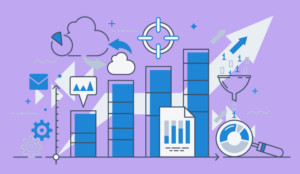Every customer interaction brings many valuable data. However, according to some studies, just 17 percent of companies act on these insights! If companies apply analytics to business challenges, they may see the real power behind the data.
Human motivations, interests, and needs are behind each of the many KPIs in call centres. This article discusses all you need to know to bring up the power of call centre analytics and use them to grow the business.
What Does Call Centre Analytics Mean?
Call centres are at the front lines of customer interaction in all businesses, so they are a goldmine for customer data.
Business leaders can find customers’ age, gender, nationality, and other valuable information through call centre interactions.
Call centre analytics gathers data from each customer encounter, evaluates it, and uses the results to draw conclusions that may be put into practice.
Using these insights, managers can outline practical plans to improve customer experience.
Additionally, they can identify the most prevalent problems with goods or services and take better measures to address them.
Why Are Call Centre Analytics Important?
Call centre analytics gathers and analyzes customer data to improve customer service performance and business intelligence.
There are many other advantages of adopting analytics in call centres, including the following:
1. Improve Call Centre Agility
The goal of establishing a contact centre is to have a committed team that can give priority to customers’ requirements and desires.
However, they cannot do it efficiently if call centre agents are overworked due to excessive call volumes and inadequate staffing.
The results are long wait times, low resolution rates, and higher customer churn rates in customer service.
By foretelling when to anticipate large call volumes, such as around holidays or product launches, call centre analytics helps leadership to avoid this.
By having more workers, managers can react to changes in demand more rapidly and handle all incoming calls.
They may also use analytics to find system and procedure weaknesses by reviewing customer interaction data.
2. Help Your Team Align on Strategy
Call centre activities are separate from other departments in a company, so managers do not combine the data from the call centre with the data from the sales department, marketing teams, and product teams.
All data sources are gathered via call centre analytics, making information sharing between teams simple and practical.
All teams may access customer data, enabling managers to understand how each department influences the others.
Call centre leaders can decide how to cooperate more effectively. For example, they may coordinate tactics with objectives to enhance customer connections and the customer experience.
For instance, when the marketing team runs a promotion, managers may inform call centre employees about it so they can promote it in both inbound and outbound calls.
If they discover via experience that the promotion might boost call volume, they can staff the call centre appropriately.
3. Encourage Objective Decision-Making
Making business judgments based solely on intuition is a poor idea. Call centres cannot achieve KPIs or optimize operations based solely on instinct.
Using call centre analytics promotes a data-driven culture. Thanks to call centre analytics, data is accessible and available to everyone within the organization.
Call centre managers can assess their agents’ productivity and identify their strengths and weaknesses.
They can also determine the potential effects of a particular choice on handle times, conversion rates, and call times.
In addition, managers may employ focused coaching to enhance individual agents’ skills and implement performance-based bonuses because call centre analytics makes performance measurable.
4. Improve Your Sales Conversions
An intelligent call centre analytics platform should proactively reveal opportunities to increase income in addition to increasing the call centre’s productivity and efficiency.
It predicts potential future customer interests using behavioral profiles, demographic data, and purchase history.
The sales agents can recommend that product to customers or tell them when a special promotion is running on it.
It also aids decision-making regarding the most efficient methods for placing outbound calls.
For instance, phone leads to later in the day rather than early in the day, which results in higher conversion rates.
Based on the best sales strategies from the past, it can also train agents on how to properly structure inquiries or modify their wording to persuade customers to buy.
5. Boost Agent Performance
Analytics technologies do more than gather consumer information. For example, they help to evaluate agents’ performance.
Call centre analytics can help leaders to identify an agent’s strengths and potential areas for improvement.
Predetermined KPIs, such as hold durations and first-call resolution rates for support agents or closing rates and deal value for salespeople, also enable managers to identify top performers systematically.
They may determine the best ways to organize call centre operations and teams to deliver the best outcomes by determining the KPIs pertinent to business goals.
When evaluating agents’ performance, inefficiencies and time-consuming tasks can be found. For example, it increases agent productivity and the company’s overall productivity.
How Does Call Centre Analytics Affect the Customer Experience?
Standing out through products or services alone is becoming more challenging, particularly in competitive industries.
To ensure that customers remember you and keep coming back, you must provide the most excellent possible customer service.
The good news is that customer data may be abundant at call centres. However, you may continually enhance the consumer experience to stay ahead of the curve.
You may track customer complaints through call centre analytics, spot problems, and take proactive steps to fix them.
You can control the performance of call centre employees to decide how to enhance the onboarding and training procedures.
For instance, you can use call whispering capabilities to train reps on-the-job during actual call circumstances, then monitor their performance metrics before and after to ascertain the efficacy of your coaching.
Finally, you can segment your customers and customize every step of their experience with the help of call centre analytics.
It accomplishes this by compiling demographic information, behavior profiles, past call recording data, purchasing history, and other data so you may customize talks to them.
What Are the 6 Types of Call Centre Analytics?
Nowadays, customers interact with businesses through up to ten different channels. However, how can call centre leaders use these channels?
There are many chances for modern businesses to gather data and provide valuable insights.
Their insights become more precise the more data they gather. However, they shouldn’t immediately use call centre analytics across every channel.
If the call centre lacks a suitable system for gathering, sorting, and evaluating data, doing this could overwhelm the agents and result in high costs.
The six most typical call centre analytics are listed below to assist firms in choosing which channels to give priority to initially.
1. Call Centre Speech Analytics
Speech analytics for call centres is concentrated on voice-based call centre technologies, like phone and video calls.
It employs artificial intelligence to recognize keywords, speech patterns, and tone to offer information about the product’s performance and agents.
Call centre leaders can also use analytics to warn agents when the conversation is taking a negative turn and may lead to losing the customer.
Call centre speech analytics also alerts managers when they need to intervene and defuse a crisis.
2. Call Centre Text Analytics
Artificial intelligence is also used in call centre text analytics to identify patterns, tones, and keywords in customer discussions.
However, they emphasize written material rather than spoken language. For example, corporate leaders can use them in emails, SMSs, surveys, feedback forms, and even social media to find patterns and connections among the data.
Call centre text analytics is crucial for contemporary firms because it might be a supplementary tool for social listening.
Data from postings, comments, messages, and brand mentions is gathered via call centre analytics.
3. Predictive Analytics
The most sophisticated analytics ever is predictive analytics. It uses machine learning to forecast customer behavior, preferences, and demands.
For example, suppose a customer mentions that they prefer writing in blue rather than red. In that case, the call centre analytics can pick up this data and predict that the customers are interested in the following blue pen product.
Predictive analytics also helps businesses to put the customers first. It offers insight into call centre activities’ peak hours and seasons, so business leaders can adequately increase staff.
4. Self-Service Analytics
Self-service analytics gathers information from self-service communication platforms like blogs, eBooks, and FAQs.
Customers are given the tools to handle their problems independently, which is frequently more convenient as it eliminates the need to wait for a customer service representative.
Self-service analytics help managers develop better self-service channels by identifying the most popular keywords and phrases.
For instance, if you find that the most often asked question about your website is “How long does the shipment take?” you might provide shipping times on the FAQ page.
Consequently, you enhance customer satisfaction while reducing the volume of incoming calls you receive for minor, everyday problems.
To make your chatbots and IVR features more convenient for your consumers and agents, you can configure them using self-service analytics.
5. Call Centre Desktop Analytics
Unlike the preceding items on this list, call centre desktop analytics are utilized to enhance your call centre operations and agent performance.
They examine call centre operators’ desktop activities and assist you in responding to inquiries like:
- How productive are my agents?
- What applications do they use during work hours?
- What procedures do they follow during and after each call?
You may evaluate your agents’ performance individually and provide them with tailored comments by keeping an eye on their desktops.
By discovering inefficient workflows in your call centre, you can also find solutions to boost efficiency.
Consequently, you can reduce the time agents spend on routine tasks and give them more time to concentrate on offering top-notch customer care.
6. Cross-Channel Analytics
Cross-channel analytics enables the omnichannel experience that customers today want.
Cross-channel analytics examines data from every channel and provides a comprehensive view of your customers’ journeys.
It aids in comprehending customers’ preferred communication channels and how each channel is utilized differently.
They also allow business leaders to segment and personalize customer service. It would be best if you had a tool that integrates with all your platforms to achieve cross-channel analytics.
Anything less, you will not have a complete 360-degree overview of your customer touchpoints and the data you are collecting.
Final Thoughts
Call centre analytics should not be apart from the rest of the company. A good analytics solution combines data across channels and takes advantage of an omnichannel approach.
This blog post has been re-published by kind permission of Scorebuddy – View the Original Article
For more information about Scorebuddy - visit the Scorebuddy Website
Call Centre Helper is not responsible for the content of these guest blog posts. The opinions expressed in this article are those of the author, and do not necessarily reflect those of Call Centre Helper.
Author: Scorebuddy
Published On: 8th Aug 2022 - Last modified: 9th Aug 2022
Read more about - Guest Blogs, Scorebuddy






 Scorebuddy is quality assurance solution for scoring customer service calls, emails and web chat. It is a dedicated, stand-alone staff scoring system based in the cloud, requiring no integration.
Scorebuddy is quality assurance solution for scoring customer service calls, emails and web chat. It is a dedicated, stand-alone staff scoring system based in the cloud, requiring no integration. 





























